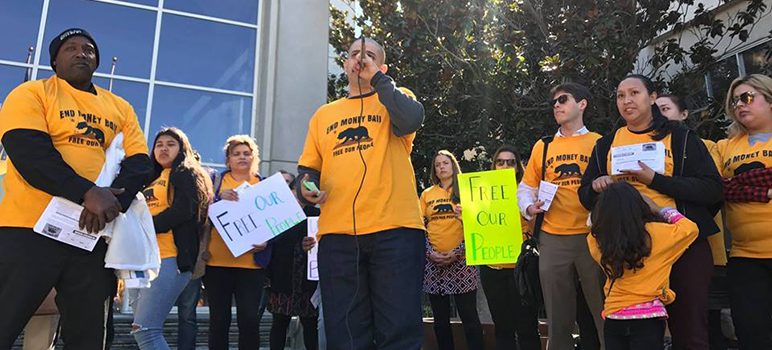When legislators introduced the bill to abolish money bail in California, it promised to be a victory for progressives trying to reverse the crisis of mass incarceration. By the time SB 10 became law, however, its strongest supporters had become its most vocal critics.
What would have been a milestone for social justice advocates instead exposed deep divisions in the criminal justice movement. “It was a huge betrayal,” says Raj Jayadev, a coordinator for civil rights nonprofit Silicon Valley De-Bug, one of the early proponents of the bill. “It sets us back I don’t know how long.”
Authored by state Sen. Bob Hertzberg (D-Van Nuys) and Assemblyman Rob Bonta (D-Oakland) and modeled after Santa Clara County’s pioneering pretrial release program, SB 10 aimed to eliminate an industry that turns freedom into a commodity and disproportionately penalizes people of color. What Gov. Jerry Brown signed last month replaces the money-based system with one of algorithmic risk assessments, giving local judges broad discretion to lock people up before they’re convicted of anything.
In the weeks and days leading up to the decision, Silicon Valley De-Bug, the ACLU and even some A-list celebrities including Kim Kardashian and John Legend led a campaign urging Brown to veto the bill. “#BailReform is needed,” Legend wrote to Brown on Twitter, “but NOT #SB10 which replaces predatory for-profit bail system with a system that threatens to expand unfair incarceration of communities of color.”
The new rules take effect in October 2019, giving California a framework “so that rich and poor alike are treated fairly,” Brown said after approving the bill on Aug. 28. San Francisco Public Defender Jeff Adachi was less optimistic, saying SB 10 merely “hands the keys to the judges.”
But SB 10’s sponsors say the reform bill stood no chance of passing without buy-in from law enforcement and the courts—namely the California Judicial Council and the Chief Probation Officers of California, which largely drove the 11th hour revisions.
“Hertzberg made the calculation that in order to get the bill out of the Assembly it would be important to have the support of other stakeholders in the criminal justice system,” says Natasha Minsker, head of the ACLU’s California Center for Advocacy and Policy.
To win over judges and probation officers, Hertzberg reworded the bill to err on the side of jailing arrestees as opposed to setting them free until trial. That’s what killed it for reform advocates such as Silicon Valley De-Bug and the ACLU, which withdrew their support over fears that over-reliance on computerized risk assessments could perpetuate racial and socioeconomic biases in the criminal justice system.
A frustrated Hertzberg says he considered pulling the legislation after the bill’s original coalition fractured. But he saw the backlash as an example of the enemy of the perfect being the enemy of the good, and calls the resulting law “pretty damn good.”
“We don’t live in a fantasy land,” Hertzberg says. “We live in a place where SB10, as written, did not have the votes.”
Part of the reason Silicon Valley De-Bug became so invested in the bail bill had to do with it drawing inspiration from Santa Clara County, which keeps pretrial services independent from law enforcement.
“The Santa Clara model is just that—it is a model and best practice and what all the counties should be moving toward,” Minsker, of the ACLU, says.
Hertzberg’s staff visited the South Bay several times to study its approach, which garnered national attention under Garry Herceg, who helmed the local Office of Pretrial Services from 2010 to 2016 until his promotion to deputy county executive. He said the goals for pretrial services are simple: make sure people show up in court and don’t commit new offenses. The best practices for pretrial agencies to follow while doing that are to maximize public safety, maximize release and maximize court appearances.
“It’s kind of common sense,” Herceg says, adding that the system shouldn’t treat someone like a criminal if he or she hasn’t been convicted as such.
But in a surprise twist, the final version of Hertzberg’s bill makes Santa Clara County the exception and not the rule, Minsker says. Though the new law doesn't require probation departments to oversee pretrial services, she explains, it gives them the right of refusal.
Another concern raised by ACLU and civil rights advocates involves the algorithmic risk assessments guiding judge’s decisions, which could potentially perpetuate biases that lead to disproportionate incarceration for people of color.
“We can all agree that the bail industry is bad,” says Jose Valle, a community organizer for De-Bug. “But we can’t do a tradeoff. Do we choose the bail industry, or do we choose the prison industry? We have to keep both parties accountable.”
The groups critical of SB 10 welcome at least one aspect of the new system, however: it prevents courts from billing people for GPS or electronic monitoring if they’re granted pretrial release. Minsker says the language assuages fears that the law would simply replace a for-profit bail industry with a for-profit monitoring industry.
Ultimately, Hertzberg believes the bill accomplishes what it set out to do by eliminating money as a condition of release.
“That injustice is 100 percent gone,” he says. “That is a giant leap forward.”


Here is a possible solution for those communities who want justice rules to be tailored to them by always playing, “the color of my skin card”- don’t break the law or don’t put yourself in a position to be a suspect in a criminal act and you will avoid jail.
David S. Wall
You have a very limited knowledge of history if you believe everyone in the criminal judicial system is there because he or she committed a crime or put themselves there.